Hercules were the first third-party video card manufacturer to combine IBM's MDA (Monochrome Display Adapter) text mode with a bitmapped graphics mode. This was considered ground-breaking in 1982, and became the de facto standard for PCs that were connected to a monochrome monitor.
The HGC (Hercules Graphics Card) standard provided a very clear 720 x 348 resolution monochrome graphics mode in addition to a text mode
which supported character blocks of 9 x 14. This was far superior to the best IBM offering at the time (CGA) which typically ran graphics in 320 x 200 (640 x 200 was the maximum in 2-colour mode) and text mode characters were a blocky 8 x 8 pixels. It wasn't uncommon for business PCs to run both a CGA card and a Hercules card simultaneously on two separate monitors.
Hercules Computer Technology, Inc.,
had offices in the US and in Germany. Their US address was 3839 Spinnaker Court,
Fremont, CA 94538,
(510) 623-6030, and in Germany they were located at
Bussardstr. 5,
D-82116 Graefelfing
Munich,
Germany.
+49-89-8989 0228
They moved into EGA and VGA territory in the late 80s before releasing their first Windows accelerator in 1991. Popular models including the Stingray and Dynamite range made use of 2D and 3D graphics accelerator chipsets from third parties such as ARK Logic, Tseng Labs, 3dLabs, S3 and Rendition.
.png) Hercules Graphics Card (HGC) Hercules Graphics Card (HGC)
Launched: 1984
Bus: ISA 8-bit
Memory: 64 KB
Max Resolution: 720 x 348
Colours in Max. Resolution:
2
Part #: GB101
Price: $499 MSRP, $309 (Dec '85)
Fully compatible with IBM's MDA, the original Hercules Graphics Card used the same 6845 CRT controller chip in order to be 100% detected as an MDA by software.
User Manual |
 Hercules Color Card Hercules Color Card
Launched: December 1985
Bus: ISA 8-bit
Memory: 64 KB
Max Resolution: 640 x 200
Colours in Max. Resolution:
4
Price: $245 (When New)
The Hercules Color Card was a CGA-compatible short 8-bit ISA card that was designed to be a direct competitor to IBM's CGA card.
Advert
|
.png) Hercules Graphics Card Plus (HGC+) Hercules Graphics Card Plus (HGC+)
Launched: June 1986
Bus: ISA 8-bit
Memory: 64 KB
Max Resolution: 720 x 348
Colours in Max. Resolution:
16
FCC ID: EW65T5HERCULESMMM
Price: $299 MSRP, $189 (Jul 1987), $169 (May 1988), $179 (Jan 1989)
The Graphics Card Plus took the original Hercules card and added redefinable fonts that can be used in text modes (the original IBM Monochrome Display Adapter and the original Hercules card had fixed fonts).
  
|
.png) Hercules InColor Card Hercules InColor Card
Launched: 1987
Bus: ISA 8-bit
Memory: 256 KB
Max Resolution: 720 x 348
Colours in Max. Resolution:
2
FCC ID: EW65T8HERCULESKSJ
Price: $299 MSRP, $299 (Jan 1989)
Aimed directly to compete with IBM's EGA and VGA cards, Hercules' InColor Card bettered the competition with its higher resolution (720 x 348 compared to 640 x 480). This higher resolution can be output to a standard EGA display. Interestingly, unlike IBM's CGA and EGA cards, the InColor Card was also backward-compatible with the HGC and HGC+, so it supported all those monochrome graphics modes.
It uses the same font ROM chip as the HGC+.
This card featured a resolution of 720 x 348 in 16 colours (when connected to an EGA monitor). The following games titles directly supported this:
- Microsoft Flight Simulator (v3.0)
- Microsoft Flight Simulator (v4.0)
- Sierra's 3-D Helicopter Simulator
Original Disks
|
.png) Hercules GB112SPS Hercules GB112SPS
Launched: 1988
Bus: ISA 8-bit
Memory: 64 KB
Max Resolution: 720 x 348
Colours in Max. Resolution:
2
FCC ID: EW65T5HERCULESLCS
Price: ?
A Hercules monochrome graphics card with printer port. |
 Graphics Station Gold Graphics Station Gold
Launched: 1991
Bus: ISA 16-bit
Memory: 1 MB
Max Resolution: ?
FCC ID:
Price: $495 (Windows acceleration version), $595 (24-bit colour depth rendering version)
Introduced at the Fall Comdex '91 event, Hercules unveiled the Graphics Station Gold card, which featured two separate designs - one for Windows acceleration and a second for 24-bit colour rendering. Based on a 60 MHz Texas Instruments TIGA graphics coprocessor, both cards came with 1 MB of RAM. |
 Graphite Graphite
Launched: 1993
Bus: VESA Local Bus
Memory: 1 MB VRAM
Max Resolution: 1280 x 1024
FCC ID:
Price: $399
The Graphite was a high-end Windows graphics accelerator, launched in 1993. It competed with the ATI Graphics Ultra Pro, Number Nine GXE, Diamond Stealth Pro, and Orchid Fahrenheit VA
"The Hercules Graphite uses IIT's AGX014 chip and comes with 1MB of VRAM. The IIT chip, from a company better known for math coprocessors, is based on the IBM Extended Graphics Array (XGA) standard and is shipped with drivers supplied by IIT and modified by Hercules. The card can reach a maximum resolution of 1,280-by-1,024 at 16 colors with 1MB of RAM. It was at the center of our benchmark controversy several months ago because its drivers cached the complete text of "The quick brown fox ..." used by earlier versions of Winbench. This resulted in very good Winbench scores, but we disallowed them. Winbench 3.11 removes the benefits of text string caching, which has no perceivable benefit to the user.
In this round, Hercules supplied new drivers without the false optimization. The Graphite card scored a pedestrian Winmark score of 8.7 megapixels per second. However, the Graphite card eeked out the top speed of 8 minutes 26 seconds in the applications tests, nosing out the ATI Ultra Pro (when enabled to complete the tests) by 3 seconds. This card turned out the highest scores in the CorelDRAW section of the applications test, 26 seconds ahead of the #9GXE, which was last in this segment. The Graphite card ranked second of third in all the other
sections of the applications test.
At a price of $399 with 1MB of VRAM memory, the Hercules Graphite
gives solid performance for a reasonable price."
PC Magazine, April 1993
|
 Dynamite Pro Dynamite Pro
Launched: 1994
Bus: ISA or VESA Local Bus
Chipset: Tseng Labs ET4000 W32i
Memory: 1 MB or 2 MB DRAM (32-bit)
RAMDAC: AT&T ATT20C490/491
Price: $164 (1 MB ISA, Apr '94), $226 (2 MB ISA, Apr '94), $119 (1 MB, Nov '94), $149 (2 MB, Nov '94), $153 (1 MB ISA, May '95), $197 (2 MB ISA, May '95)
Part #: D301 (1MB ISA), D302 (2MB ISA), D602 (2 MB VLB), HS501 (1 MB VLB version?), HS601 (2 MB VLB version?)
FCC ID: EW65T5HERCULESJSL
The Hercules Dynamite Pro was based on the Tseng Labes ET4000 W32i graphics accelerator chipset. |
.png) Stingray Stingray
Launched: 1994
Chipset: Avance Logic ALG2228 (VLB) or ALG2301 (PCI)
Bus: VESA Local Bus (S501) or PCI (S801)
Memory: 1 MB or 2 MB DRAM (32-bit)
RAMDAC:( Embedded)
Price: $99 (1 MB, Nov 1994)
Part #: HS501, AV9401 (VLB version)
FCC ID: JQDA2228AV9401 (VLB), DXL9IL631C (PCI)
The Hercules Stingray is based upon the Avance Logic ALG2228 chipset which supported both the ISA and VESA Local Bus interfaces, and ALG2301 on the PCI bus.
More Images
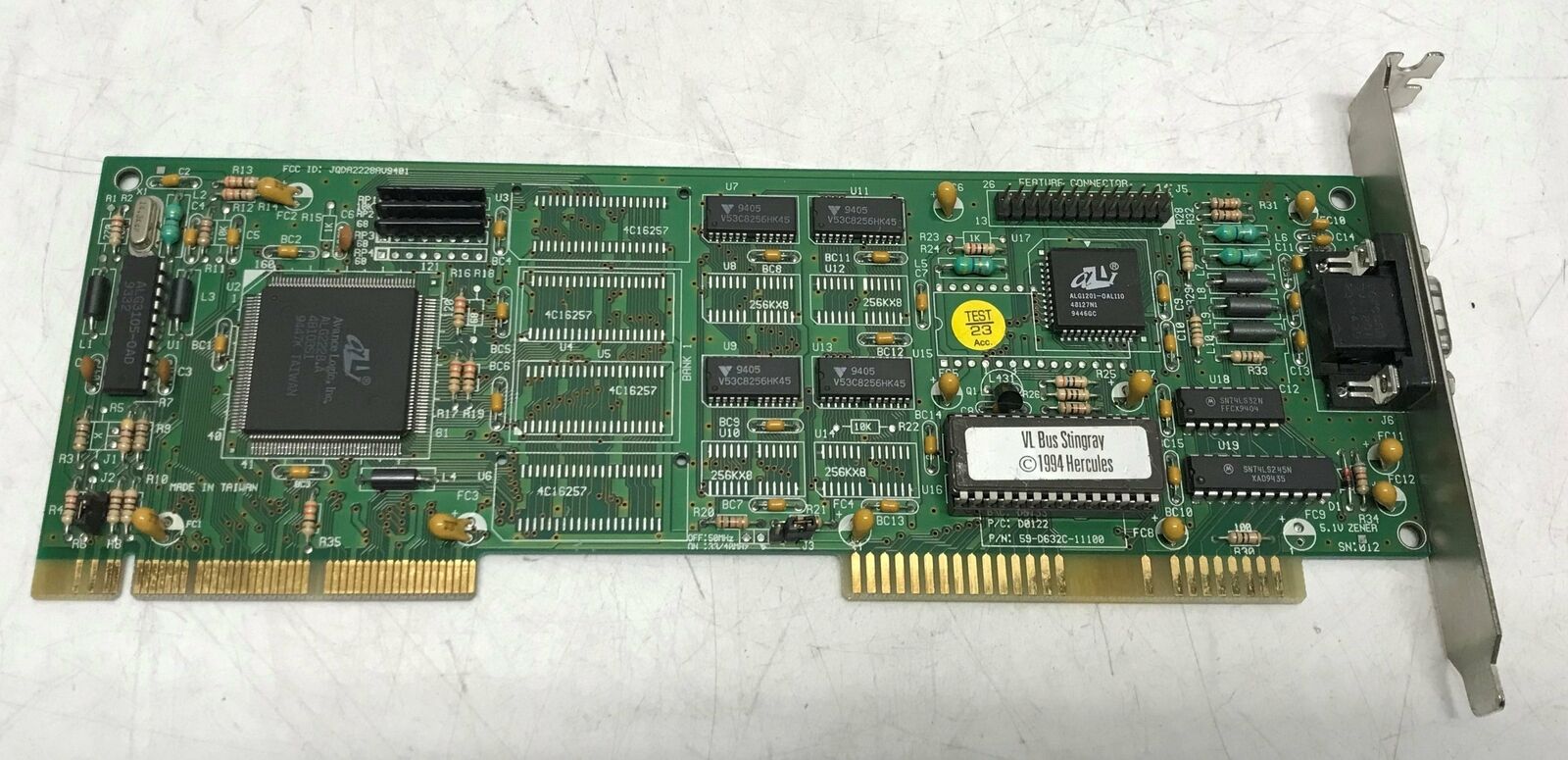 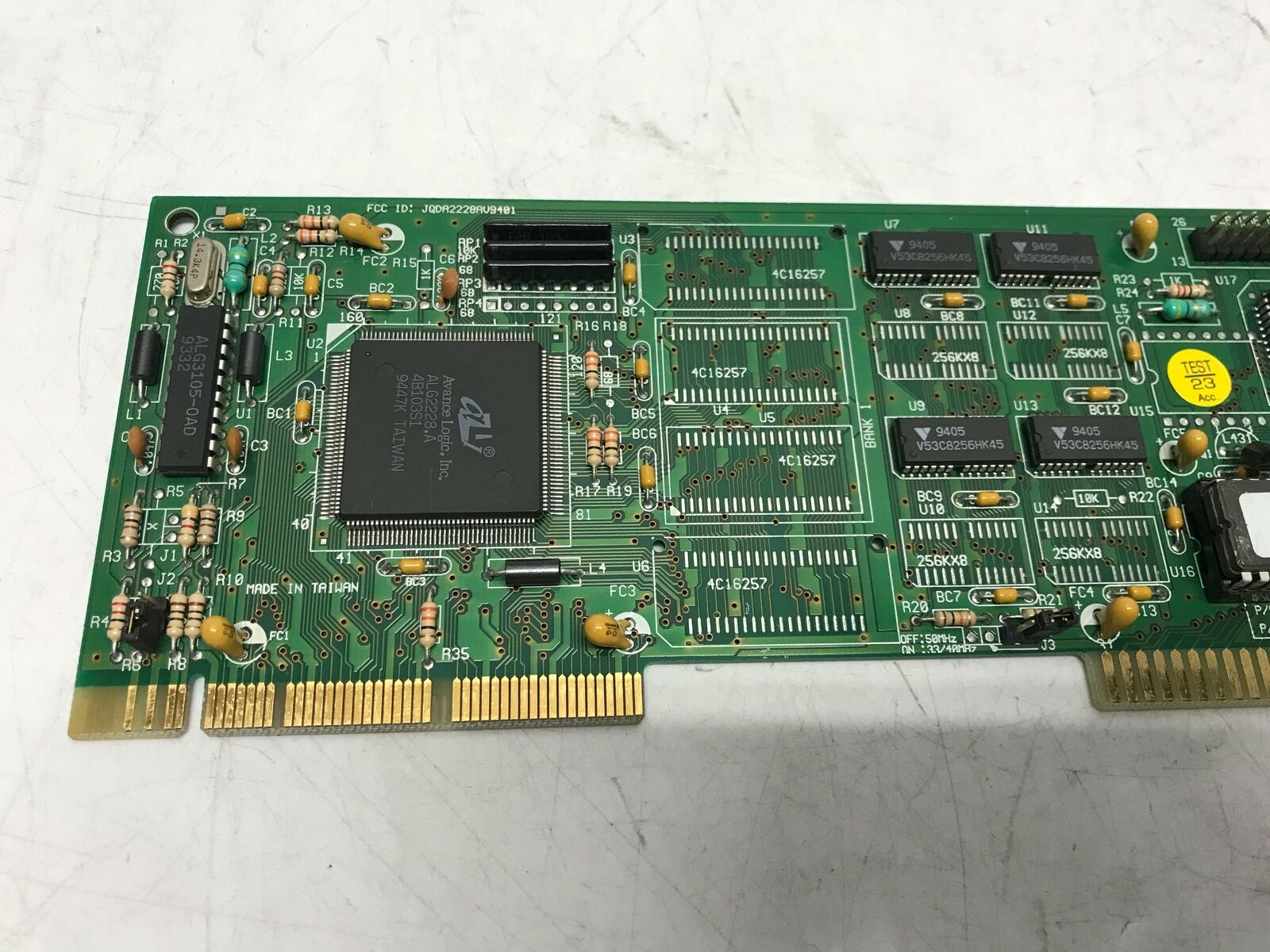 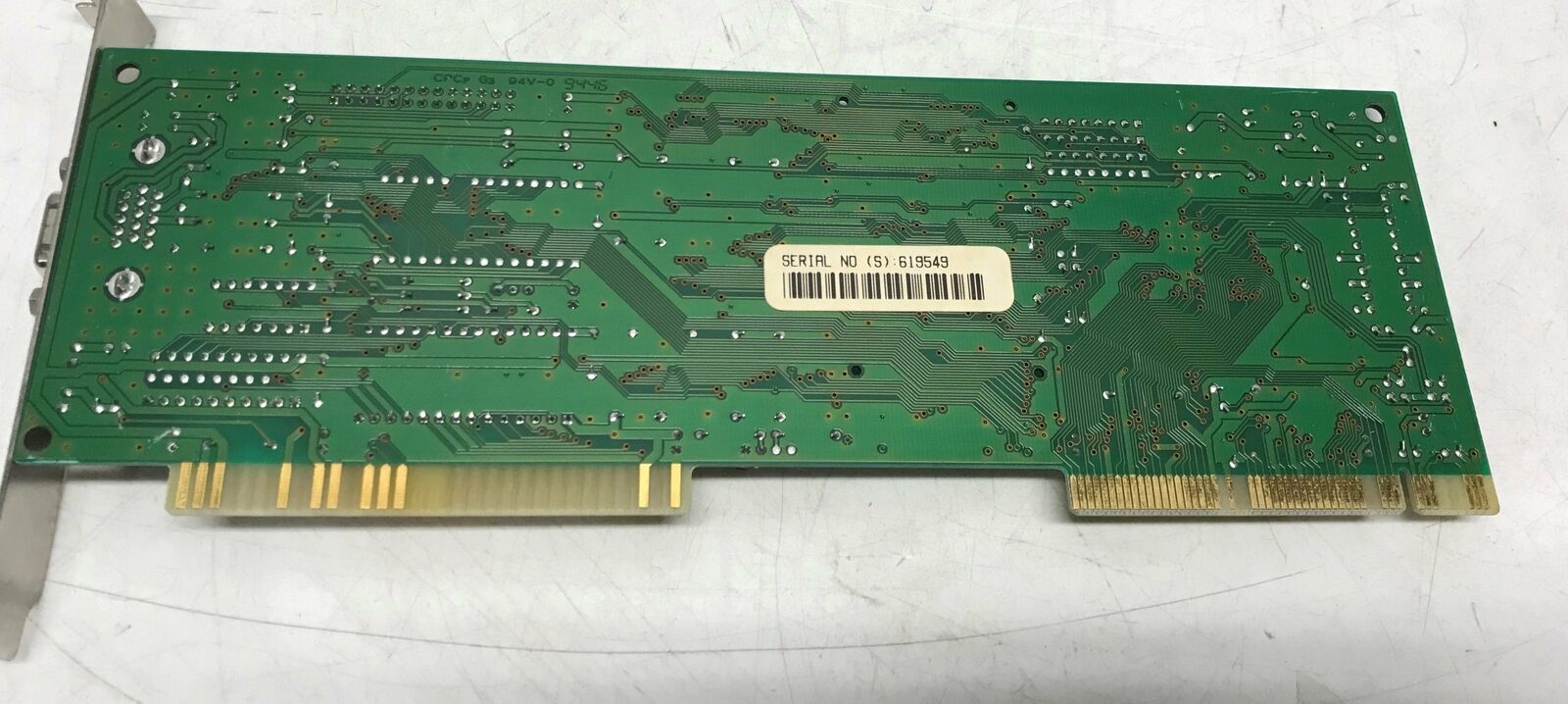 
|
 Stingray Pro / Stingray Pro/Video? Stingray Pro / Stingray Pro/Video?
Launched: 1995
Chipset: ARK Logic 1000MT
Bus: PCI (S901e) or VESA Local Bus (S601e)
Memory: 1 (32-bit, 60ns) or 2 MB DRAM (32-bit, 45ns)
RAMDAC: ARK1491, ATT20C490, ATT20C498 (Pro) / I.C. Works ZoomDAC (Pro/Video)
RAMDAC Speed: 110 MHz
up to 135 MHz
Part #: GB-3020
Price: ?
FCC ID: DXLDP401, DXL9IL640B, LBG-1000PVZM
The Hercules Stingray Pro is based upon the ARK Logic 1000MT chipset, which was very efficient and had very aggressive DRAM timing. It supported an 8-bit DAC that ran at 135 MHz.
The Stingray Pro and Stingray 64 are both great
cards for DOS gaming - faster than even the Tseng Labs W32p in most instances and have slightly better
performance than the S3 Vision-based Terminator series.
Several RAMDACs were provided on Stingray Pro cards, including an 8-bit colour depth (ATT20C490) and a 16-bit colour depth (ATT20C498).
Later in 1995, a PCI version of the Stingray Pro with model number S901v was launched that included Hercules' new Power Playback video acceleration technology.
Other cards that also used the ARK Logic 1000MT chipset include:
- Unknown card (FCC ID: LBG-1000PV2MA)
- Octek PVGA-1000 (1 MB card)
|
.png) Terminator 64 / Terminator 64/Video Terminator 64 / Terminator 64/Video
Launched: 1995
Chipset: S3 Trio64V (64) or S3 Trio64V+ (64/Video)
Bus: PCI
Memory: 1 MB (model S1201V), 2 MB (S1202V)
RAMDAC: ICS GENDAC ICS5342-3 / ZoomDAC (64/Video)
RAMDAC Speed: 135 MHz
Price: $259 (Dec 1995)
FCC ID: LBG-2000PV2M
The Hercules Terminator 64 is based upon the S3 Trio64V chipset, and came in two models:
- S1201V - 1 megabyte of video memory
- S1202V - 2 megabytes of video memory
The Terminator 64/Video was based on the 64-bit S3 Trio64V+ graphics and multimedia engine, and came in three models:
- T2211 - one megabyte of DRAM, upgradeable to two megabytes.
- T2212EDO - two megabytes of ultra-fast single-cycle EDO DRAM for even more performance.
- T2212MEDO two megabytes of single-cycle EDO and includes MPEG decompression.
All versions of the Terminator 64/Video had software MPEG decompression. Both the T2211 and T2212EDO could be upgraded to a T2212MEDO with the purchase of an MPEG Decompression daughtercard, Model TMPEG2000.
More Images
 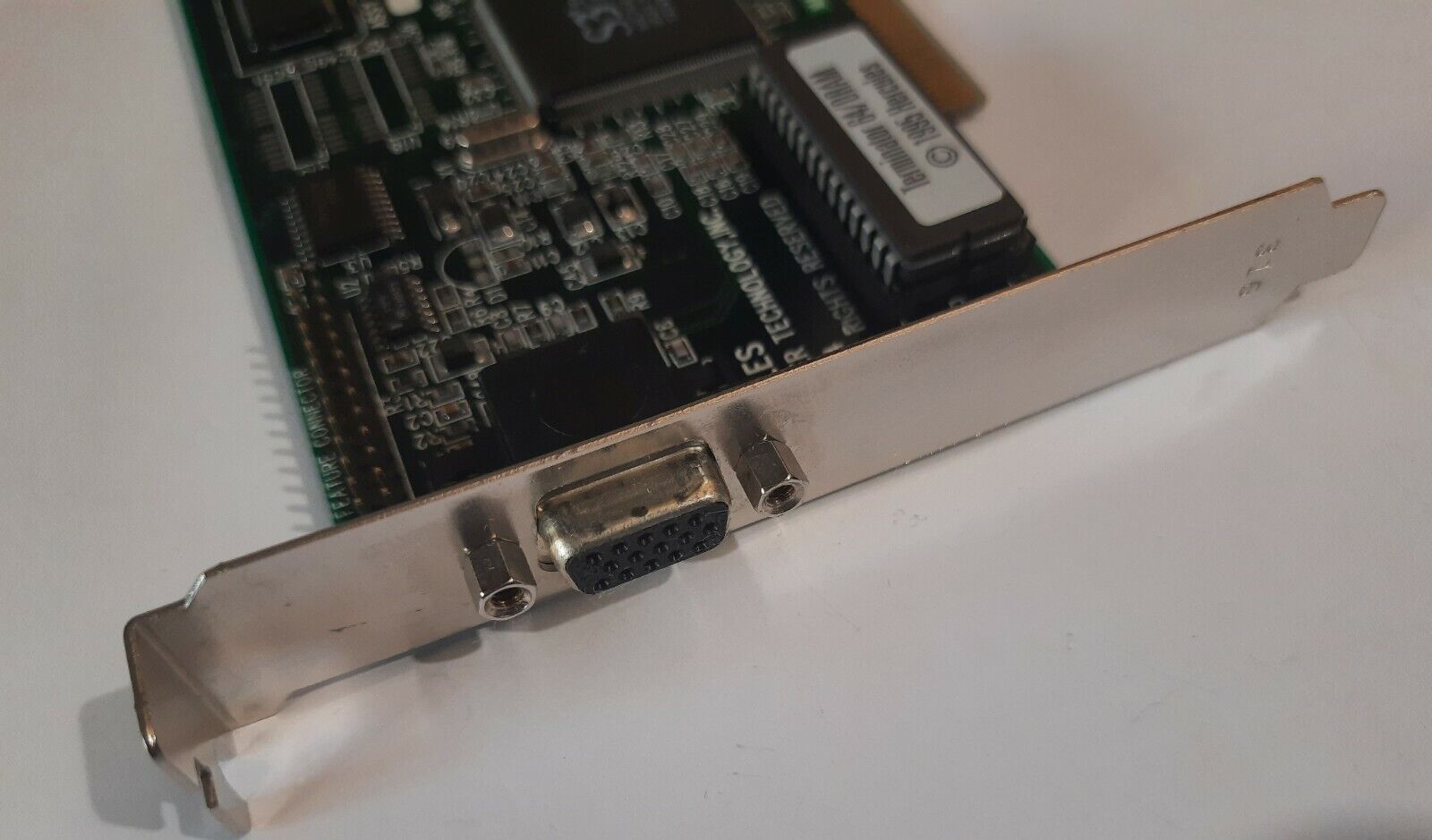
|
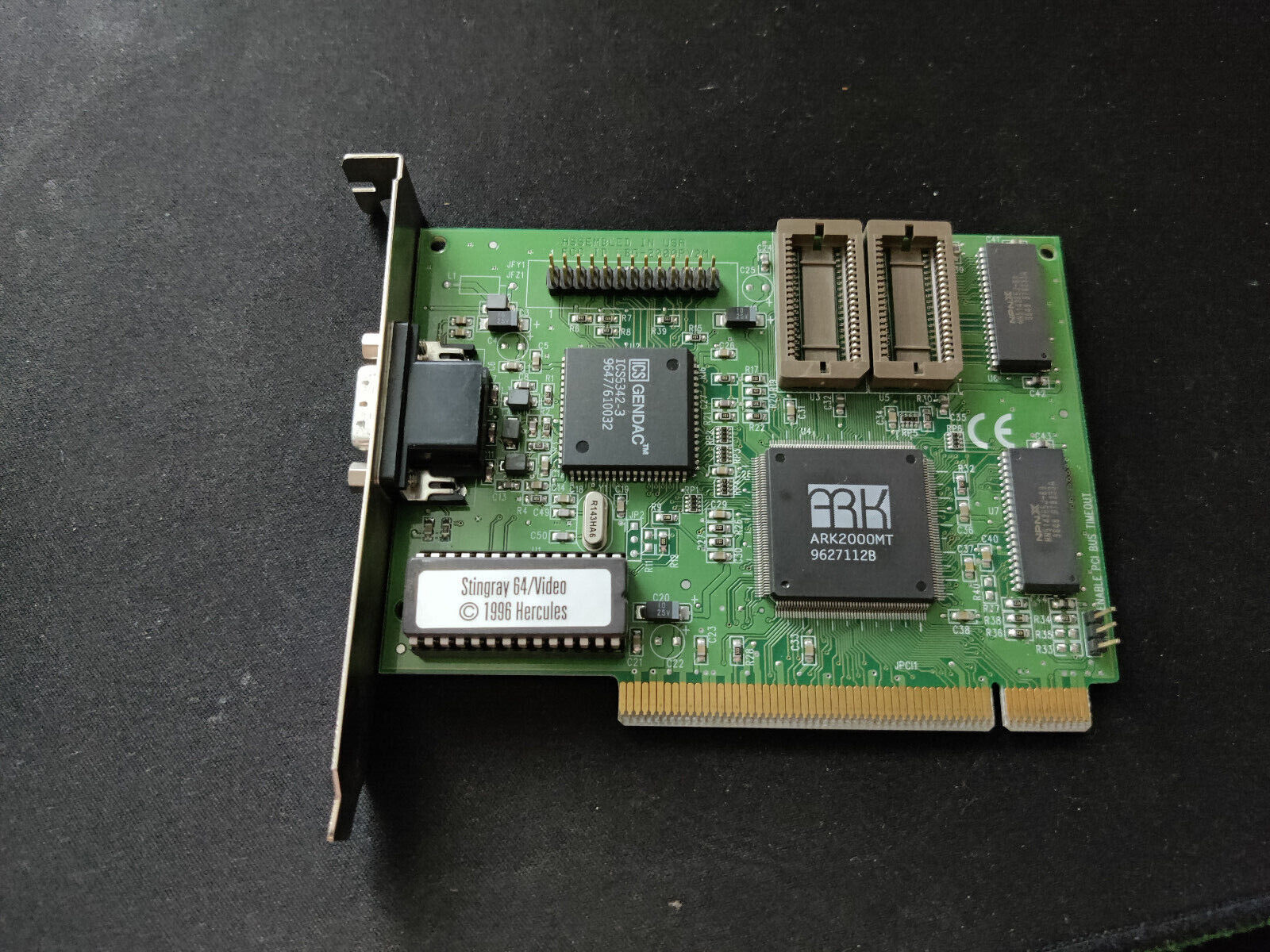 Stingray 64 / Stingray 64/Video Stingray 64 / Stingray 64/Video
Launched: 1996
Chipset: ARK Logic 2000MT
Bus: PCI
Memory: 1 MB (model S1201V), 2 MB (S1202V)
RAMDAC: ICS GENDAC ICS5342-3 / ZoomDAC (64/Video)
RAMDAC Speed: 135 MHz
Price: $259 (Dec 1995)
FCC ID: LBG-2000PV2M
The Hercules Stingray 64 is based upon the ARK Logic 2000MT chipset which used a 16-bit DAC that ran at up to 120 MHz. The 2000MT was a superset of the earlier ARK 2000PV and added video support.
The Stingray 64/Video came with a 24-bit DAC that ran at up to 135 MHz. The 1 MB version of the 64/Video came with two sockets for memory upgrade to the full 2 MB supported by the ARK 2000MT.
Like the Stingray Pro, the Stingray 64 is known to be one of the fastest cards for DOS gaming. Unlike the Stingray Pro's DRAM, Stingray 64 used the faster VRAM which ran at 60ns. It came in two models, S1201V and S1202V, denoting the amount of onboard VRAM.
The Stingray 64 came with Hercules' new Power Playback video acceleration technology.
"Hercules has built some comfort into its Stingray 64/Video ($259) and Graphite Terminator Professional ($389) accelerators, but neither product is built for speed. Both boards come with an improved set of utilities for Microsoft Windows 3.x, and the Terminator Professional's 220-MHz IBM Palette DAC provides a rock-steady display, but these boards came up short on some of our performance tests.
Both boards "feature" a combined DOS and Windows 3.x setup routine that is needlessly complex. Each installation begins under DOS. That lets you decompress the DOS-based refresh rate utilities and Windows 3.x drivers and run the monitor-selection program. After choosing a monitor from an admiringly long list of supported models, the program modifies your AUTOEXEC.BAT
file to set the refresh rates. The you close Windows, start it up again, and run Windows' own setup program from the Control Panel. After selecting the proper display driver, you need to reboot to set the refresh rate and start Windows 3.x again to begin using the new drivers and utilities.
Windows 95 support was meager at the time of this roundup, but we were able to set the Stingray's Windows 95 refresh rate with the card's DOS utility, and the Terminator Professional's driver negotiated a decent refresh rate via Windows 95's monitor.INF files.
Hercules bundles Xing's MPEG player and a nicely designed set of Windows 3.x utilities with both cards. In addition to Picture Window, which lets you see the resolution and color depth, the company provides a Refresh Rate Meter that displays the current refresh rate, a wallpaper selection utility, and two little video-oriented gems: PowerPreview and PowerPlayer. If you've ever tried to search through a long list of video files to find the one you want
to play, you'll appreciate PowerPreview. The program lets you quickly browse through directory trees, displaying thumbnail-size single-frame depictions of each .AVI file, and you can play the entire file via the Power Player utility directly from within Power Preview.
When we paired the Terminator Professional with a Nanao F2-17 monitor and tested the card's refresh rate, we were in for quite a shock. Hercules' Refresh Rate Meter read 150 Hz at a resolution of 640-by-480 pixels in 24-bit color; we verified that result
with a hand-held Extron meter. The board was able to sustain admirably high refresh rates to a resolution of 1,280-by-1,024 pixels, where the board tops out at 85 Hz. On the top-flight Nanao monitor, the display was crisp and clean, with vivid colors and no dicernible flicker.
Unfortunately, the Terminator Professional performed poorly on our WinBench 96 and Winstone 96 tests. The card managed average WinBench performance at 1024-by-768 pixels in 256-color mode, but ranked last or next to last among its S3 Vision968-based peers at every other resolution and color depth, and its Winstone results were nearly as poor. Video performance was on a par with other Vision968-based boards, generally the lowest-scoring group in the roundup.
The Stingray has a nearly identical graphics performance profile, but the Stingray's 256-color performance is quite good, and its ZoomDAC can take advantage of this by displaying true-color video within a 256-color graphics stream. The ZoomDAC also provides the Stingray with first-rate video playback performance: Its scaling engine delivered high frame rates and low CPU utilization
numbers on nearly every test. Whenever we forced the board to clip the video display by partly obscuring the playback window with a graphics object, however, the playback rate dropped precipitously and the CPU utilization on our 133-MHz Pentium test-beds rose to nearly 100 percent.
These two products were somewhat of a disappointment. Hercules virtually invented the original PC graphics display, but that was over ten years ago. The best things about these cards are the Power Preview and Power Player utilities, which work with virtually any hardware. As a low-cost entry into video-enhanced computing, the Stingray 64/Video is not a terrible choice, but be prepared to tolerate some unusual effects. The Graphite Terminator Professional provides
a much more stable platform, but the Vision968-based card offers little to recommend it over the other boards in its price range."
PC Magazine, December 1995
More Images
|
 Stingray 128 Stingray 128
Launched: 1996
Chipset:
Bus:
Memory:
RAMDAC:
Price: ?
FCC ID:
|
 Terminator 3D Terminator 3D
Launched: 1995?
Chipset: S3 ViRGE (86C325)
Bus: PCI
Memory: 2 MB or 4 MB EDO DRAM
Memory Speed:
RAMDAC Speed:
Part #: T2312EDO, T2132MEDO, T2314EDO, T2314MEDO
Price:
FCC ID:
The Terminator 3D was released in late 1995, based on the 64-bit S3 ViRGE graphics and multimedia chipset, offering graphics acceleration and software MPEG capabilities. It fully supported Direct3D and DirectDraw in Windows.
The Terminator 3D came in four versions:
- T2312EDO (2 MB, no hardware MPEG)
- T2312MEDO (2 MB with hardware MPEG)
- T2314EDO (4 MB, no hardware MPEG)
- T2314MEDO (4 MB with hardware MPEG)
For the non-hardware MPEG models, this was an optional extra you could buy later, via an MPEG decompression daughtercard, model TMPEG2000. |

Dynamite 128 / Dynamite 128/Video
Launched: 1996
Chipset: Tseng Labs ET6000
Bus: PCI
Memory: 2 MB MDRAM (64-bit)
Max Resolution: 1600 x 1200
Colours in Max. Resolution:
8-bit (256)
Supported Resolutions: SVGA (800x600), SXGA (1280x1024), VESA BIOS VBE 2.0, VGA (640x480), XGA (1024x768)
FCC ID: EW65T5D128P
Part #: D5202/20 (128?), GB7010P (128/Video short board), GB7015P (128/Video long board)
Known Board Revisions: v1.1 (short board), v2.1
(long board)
Price: $230 (street price at launch)
The Dynamite 128 based upon the Tseng Labs ET6000 chipset, which had an integrated 24-bit RAMDAC that ran at 135 MHz.
Some later board revisions, e.g. v2.1, are longer cards that come with two MDRAM sockets on the far right of the board to upgrade the memory to 4 MB(?). On earlier revisions, the card is shorter (see pic above) and does not have a socket for memory upgrades.
The Dynamite 128/Video is a major breakthrough in graphics and multimedia technology. It offers significantly higher performance at lower cost than many expensive VRAM boards.The Dynamite 128/Video combines one of the fastest 128-bit graphics processors, the state-of-the-art ET6000 from Tseng Labs, and the industry's fastest, synchronous Multibank DRAM (MDRAM). Taking advantage of Hercules' proprietary hardware design in combination with Hercules' Power Drive software drivers, the Dynamite 128/Video also delivers industry-leading performance for 3D games and 3D applications under Windows 95. VESA compliant stereoscopic connector for Stereo 3D glasses is included.
"The latest 2-D graphics accelerators deliver stunning video and gaming performance at an affordable price, but they may be the last hurrah for 2-D graphics hardware. We tested three cards: Hercules Dynamite 128 ($238 street), STB Systems' Lightspeed 128 ($200 street), and VideoLogic's GrafixStar 600 ($180 street). Each delivered impressive video capabilities. They also showed exceptional gaming promise under Microsoft Windows 95 and flew through our graphics benchmark tests.
All three cards pair Tseng Labs' ET6000 accelerator chip with 2.25MB of MoSys' MDRAM (Multibank DRAM). Though the chip's memory pathway is technically 128 bits wide, a closer look reveals that it functions
like two 64-bit paths, churning 128-bits of graphics data every two clock cycles. Technicalities aside, it's hard to argue with the results: ZD WinBench 96 and ZD Winstone 96 test scores on a par with those of a comparably equipped Matrox Millennium [4 MB WRAM], our most recent Editor's Choice (June 1996).
The ET6000 is compatible with standard DRAM chips, but the key to these products' performance edge is the use of MDRAM. MDRAM contains up to 32 separate banks, each with its own row and column structure. With up to 32 rows active, concurrent processes that repeatedly access the same memory areas can be serviced more quickly than with standard DRAM. The result is that such operations as screen refreshes, off-screen manipulations (important for video and DirectX games), and standard GDI services can often be executed simultaneously in graphics memory without causing significant decrease in performance.
With 2.25MB of memory, theoretically all three of these cards can support 24-bit color at 1,024-by-768 resolution, but none currently offers this mode. Instead they top out at a resolution of 800-by-600 at this color depth but can display 1,280-by-1,024 pixels in 8-bit color.
In 16-bit color mode, the Lightspeed 128 and GrafixStar 600 support a top resolution of 1,152-by-864, but the Dynamite 128 tops out at 1,024-by-768 pixels.
The Dynamite 128 performed as well as or better than its two siblings and was competitive with the Matrox Millennium card on our Graphics WinMark 96 test with a score of 24.9 million pixels per second. But its ZD Winstone 96 scores were nearly 20 percent lower than those of the Lightspeed 128 and GrafixStar 600, which effectively tied the Matrox Millennium on this test.
Accelerator cards with 3-D support are already beginning to hit the streets. But in case you can't wait, these graphics accelerators offer top-notch video playback and 2-D graphics performance at very competitive prices."
PC Magazine, September 1996
|
 VL Bus Dynamite 128 VL Bus Dynamite 128
Launched: 1997?
Bus: VESA Local Bus
Chipset:
Tseng Labs ET4000 W32p
Memory: 2 MB
Price: ? |
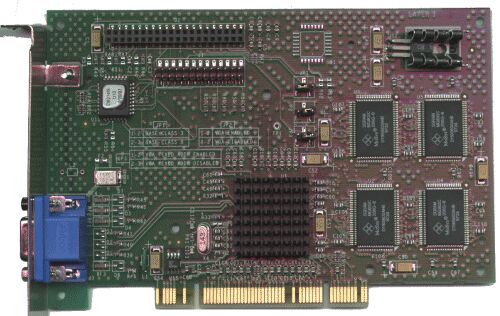 Dynamite 3D/GL Dynamite 3D/GL
Launched: 1997
Bus: PCI
Chipset:
3DLabs Permedia 2
Memory: ? MB
Price: $284 (December 1997)
A poor-performing card when compared to the Diamond FireGL.
"The new Dynamite 3D/GL is using 3DLabs :Permedia 2 chip, so that shows you where to put the Dynamite 3D/GL, it's pretty much Hercules' first professional card for a long while. 3DLabs' Permedia 2 is known for very good 2D performance, the best OpenGL performance in this price group and a pretty good Direct3D performance as well, although it's not offering the highest 3D image quality due to some missing features.
I am happy to see a Hercules product with this chip, which in my eyes is one of the best 3D chips currently available, unless you're a hardcore gamer who doesn't care for anything else.
Due to the fact that I've only received the card here in Fremont, CA, it will take until after Comdex to run tests and benchmarks, but we could expect higher results than with Diamond's Fire GL 1000 Pro, because the Permedia 2 chip is clocked with 90 MHz or even more against only 83 MHz in case of the Diamond card."
Toms Hardware, November 1997
"The Dynamite 3D/GL fared somewhat better across the board, thanks to its implementation of 3Dlabs' Permedia 2 accelerator. The Permedia 2 combines 2-D and 3-D operations on a single chip, and dynamically allocates all of its on-board memory to any task at hand; it even uses a few of its 3-D capabilities to accelerate some 2-D functions, such as pattern fills and video acceleration. The Permedia 2 also integrates 2-D, MPEG-2 video, and 3-D acceleration under both Direct 3D and OpenGL.
During testing, the Dynamite 3D/GL posted top-tier scores in our 2-D test suites, performing within fractions of a point of the leader in Winstone and among the leaders in WinMark. In 3-D testing, the card matched or bettered the Stingray 128/3D's quality and performance, and was again among the leaders.
The video quality of both boards was quite good; both are capable of displaying multiple simultaneous video streams
with little apparent effort. Both boards also support a wide array of 3-D features and effects. During testing, the Stingray 128/3D correctly implemented perspective correction, specular highlights, alpha blending, fog, and several MIP-map modes (but not linear MIP-map combinations). The Dynamite 3D/GL matched its cousin feature by feature, though the driver we tested with had minor trouble with some fog modes.
In the rapidly changing
world of PC graphics engines, the multichip Stingray 128/3D looks outmoded in comparison with new single-chip multifunction boards such as the Dynamite 3D/GL. The latter card offers greater flexibility and somewhat faster performance, with little noticeable trade-off in quality. While dedicated gamers may appreciate the Stingray 128/3D's high-quality 3-D output, general business users will be happier with the Dynamite 3D/GL."
PC Magazine, December 1997
|
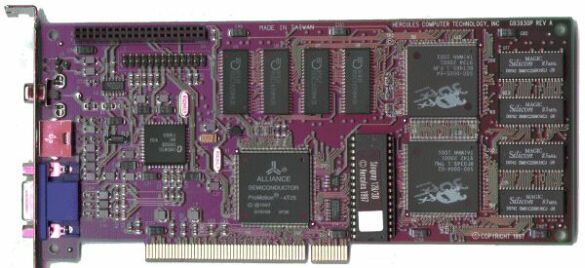 Stingray 128/3D Stingray 128/3D
Launched: August 1997
Chipset: Alliance ProMotion AT25 / 3Dfx SST96
Bus: PCI
Memory: 4 MB, 6 MB or 8 MB EDO (128-bit)
RAMDAC Speed: 50 MHz
Model #: S3910P, S3930P, S3318TV
Price: $300 (street price at launch), $284 (Dec 1997)
FCC ID:
The Hercules Stingray 128 3D was their 3dfx Voodoo Rush card which provided both 2D graphics acceleration via its Alliance Semiconductor ProMotion AT25 chip, and 3D acceleration via the 3dfx chips.
Its 8 MB of EDO RAM is shared, 4 MB for the AT25's frame buffer, and 4 MB for the texture memory for the Voodoo, which runs at an incredible 28ns!
"We tested preproduction boards from Hercules, VideoLogic, and ATI to see what the next generation of video accelerators will deliver. Each takes a different approach to integrating 3-D functionality into a mainstream graphics accelerator, and all three make substantial strides in 3-D performance and image rendering.
Hercules' Stingray 128/3D ($300 street price) is the first fruit of a collaboration between 3-D specialist 3Dfx and mainstream 2-D chip maker Alliance Semiconductor. Designed to provide top-flight 2-D, 3-D, and video playback performance in a single PCI slot, the Stingray relies on the 128-bit Alliance ProMotion 128/3D graphics chip for 2-D and video, while referring 3-D requests to 3Dfx's Voodoo Rush chip set, located on a daughtercard.
We used the Stingray
128/3D as a reference high-end board. The card's performance on the 3D Graphics WinMark tests was compelling. It turned in a score of 105.6 versus 63.8 for the best performer of this roundup."
PC Magazine, June 1997
The card does not have enough memory for a Z-buffer at resolutions higher than 800-by-600 in 16-bit colour, and does not support 3D in true colour modes.
The Stingray 128/3D also provided an output for stereo glasses as well as a TV out.
More Images
 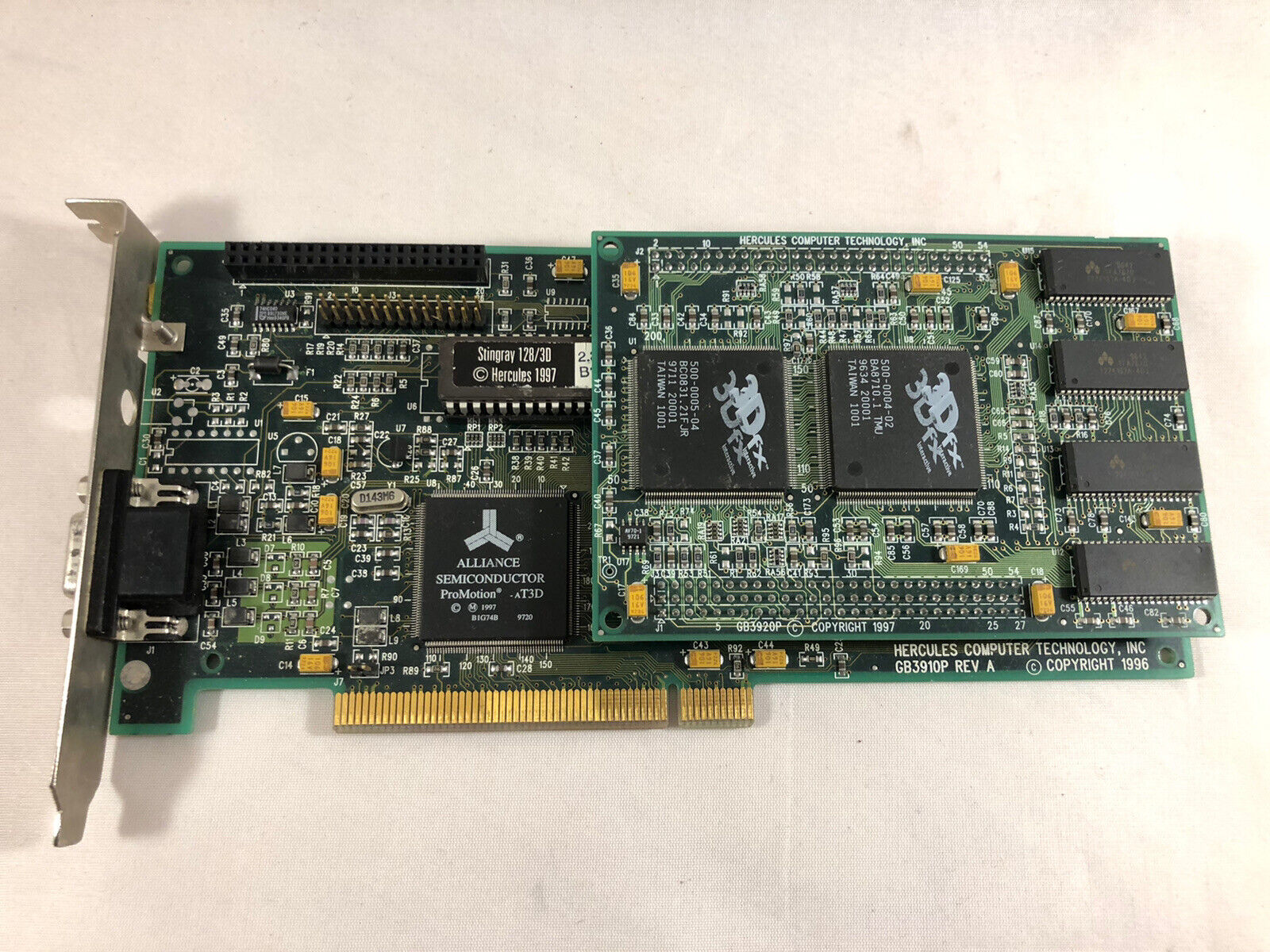  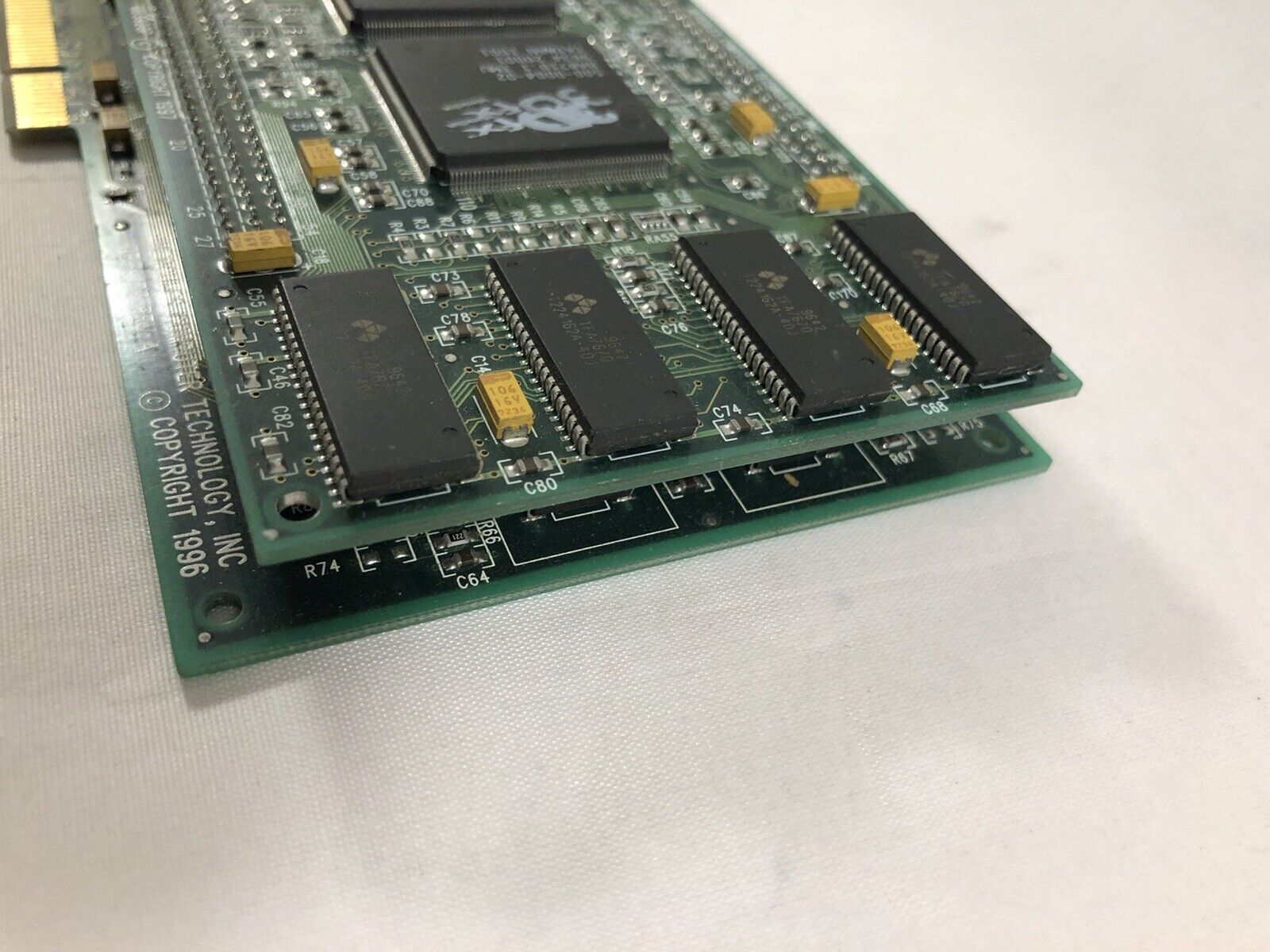 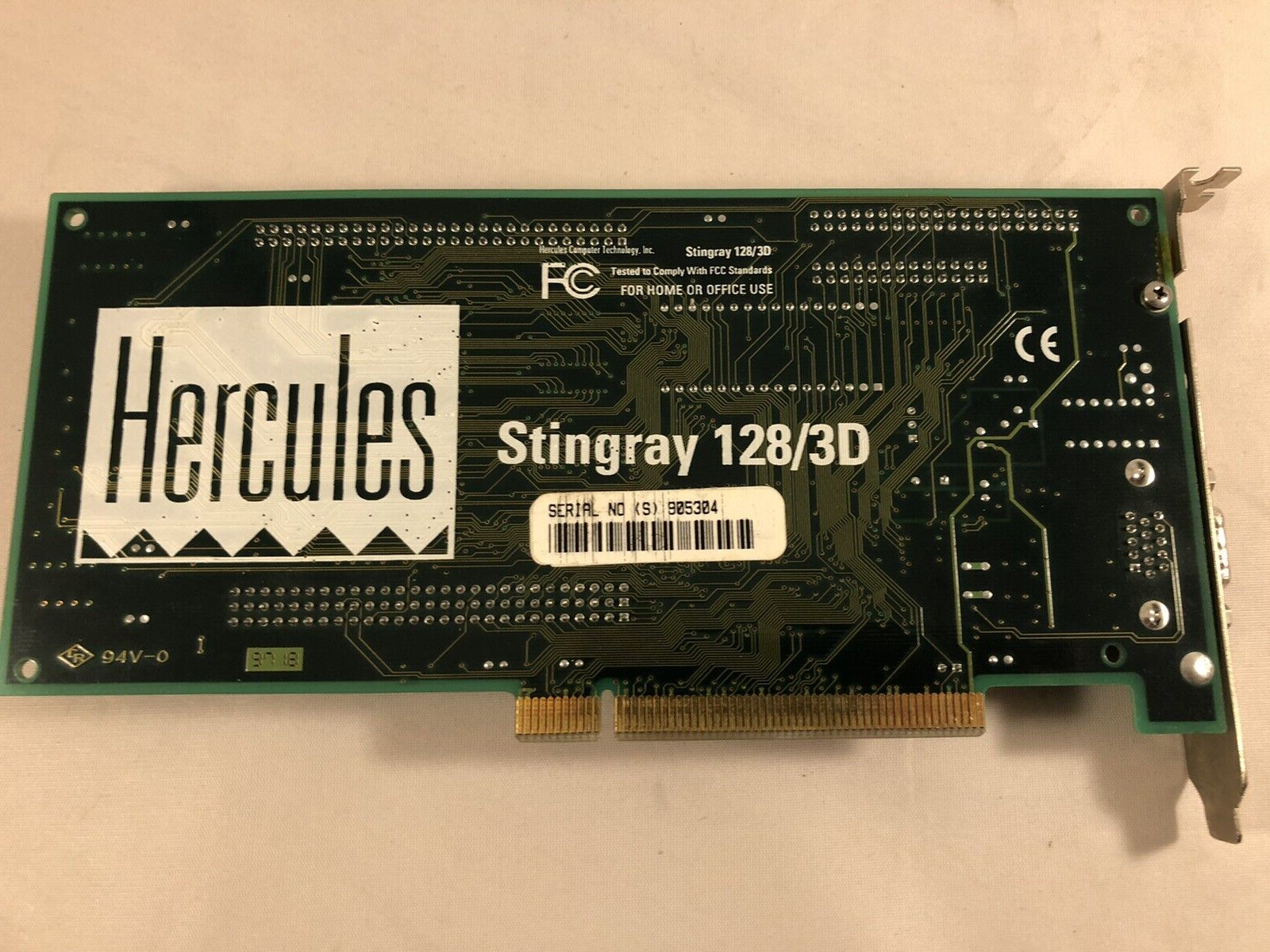 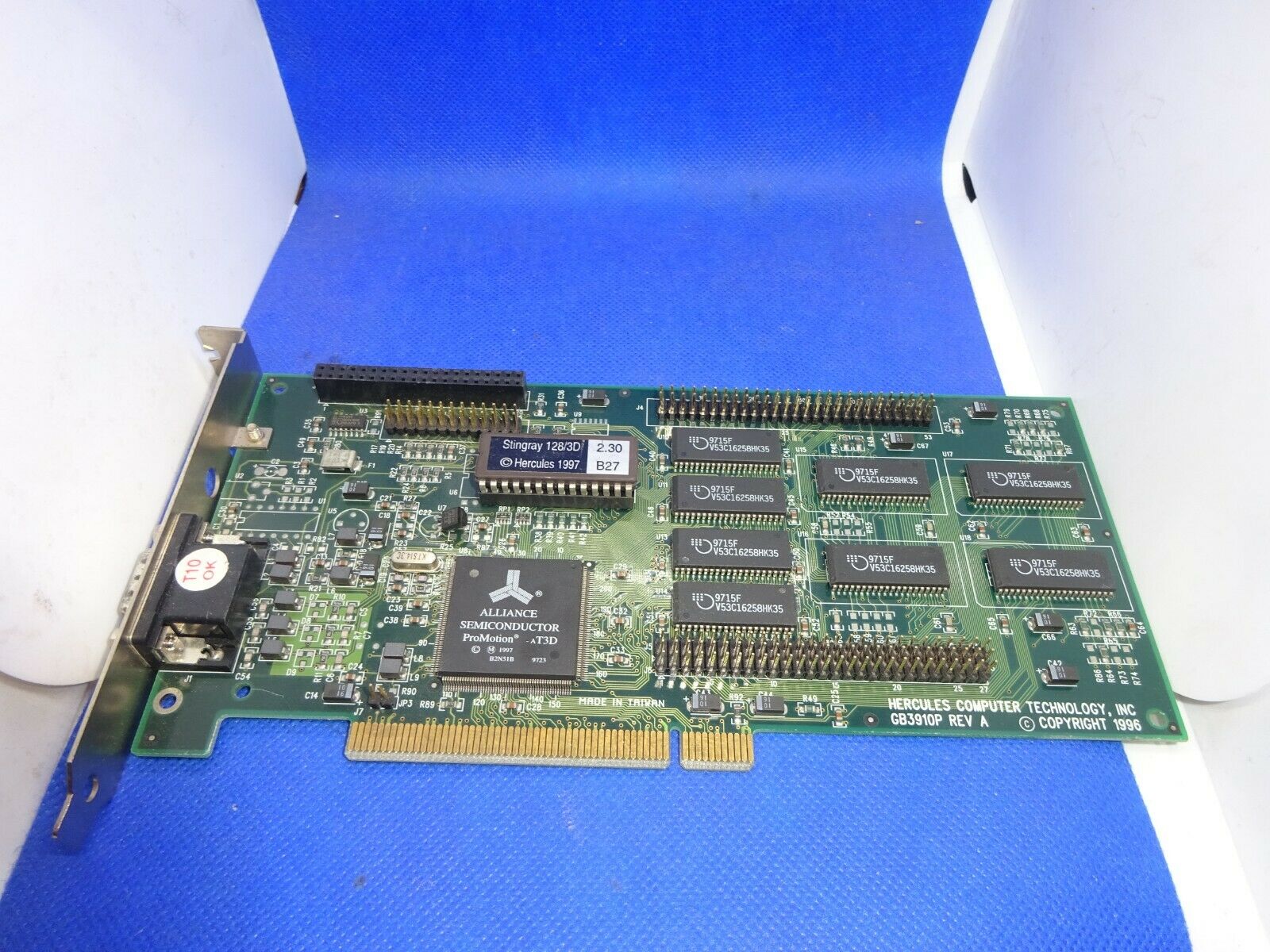   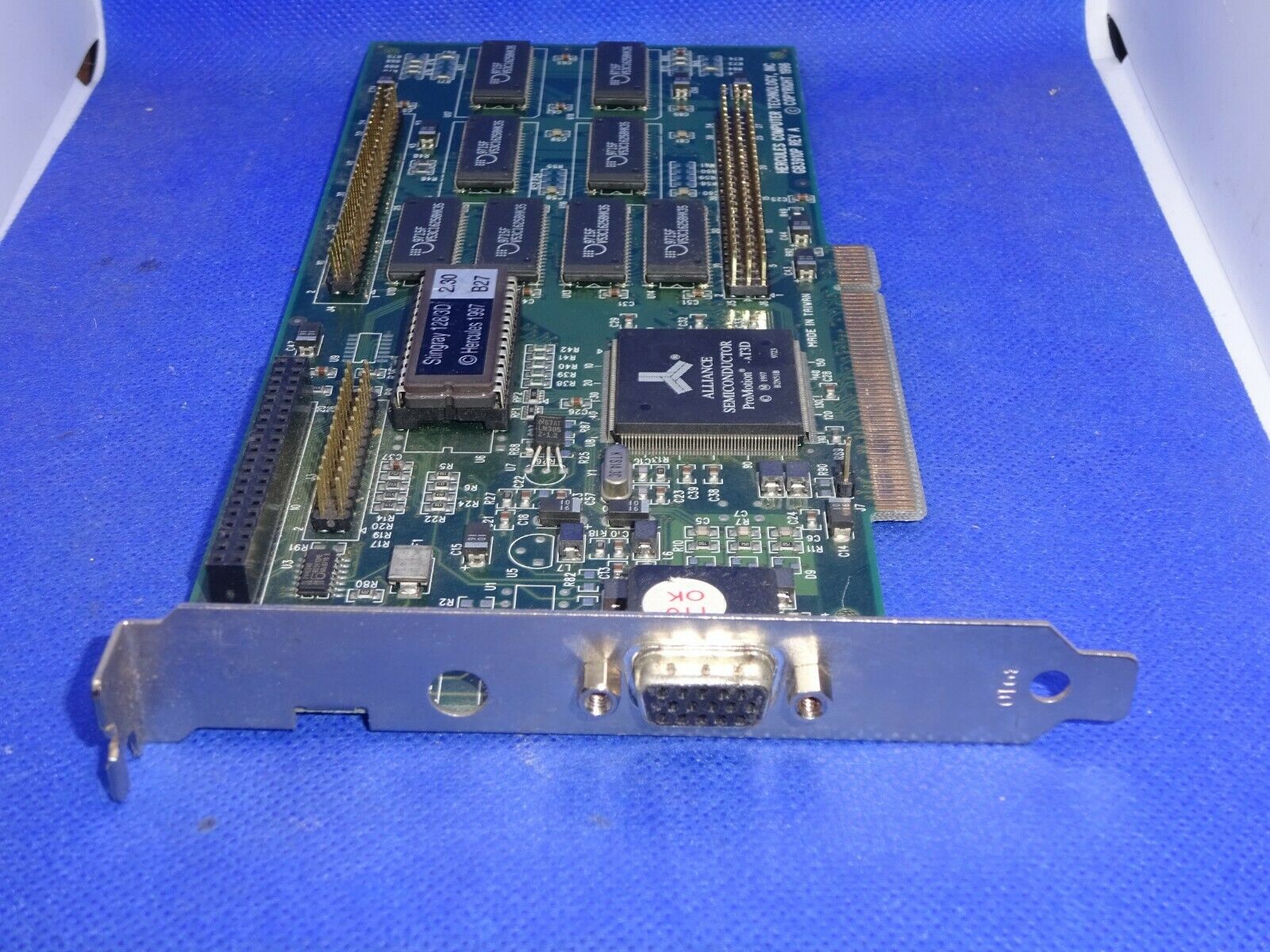 
|
 Terminator 3D/DX Terminator 3D/DX
Launched: 1997
Chipset: S3 ViRGE/DX (86C375)
Bus: PCI
Memory: 4 MB EDO DRAM (64-bit, 35ns)
Memory Speed: 50 MHz
RAMDAC Speed: 170 MHz
Part #: GB3610P
Price: $169 list price at launch
FCC ID: EW65T5BPLP
The Hercules Terminator 3D/DX was built around S3's ViRGE/DX chipset, a combined 2D engine from the Trio64V2 and 3D graphics engine.
The integrated RAMDAC is 32-bit and runs at 170 MHz.
"Hercules' reasonably priced Terminator 3D/DX ($169 list, $150 street) provides strong 2-D performance, and its support for a range of operating systems makes it ideal for MIS departments serving multiple environments. But for 3-D gamers or anyone gearing up for the coming 3-D business applications, the Terminator's 3-D performance won't satisfy.
The ViRGE DX-based board includes drivers and documentation for Microsoft Windows 95, Windows 3.1, Windows NT 3.51 and 4.0, and OS/2 Warp - one of the widest offerings among the products in this review. Hercules also bundles MPEG-1 and MPEG-2 players and Decent II: Destination Quartzon.
Setting up the Terminator was as simple as inserting the CD-ROM into the drive (though you have to install the MPEG-1 playback
drivers separately). However, we found the Touch display utilities disjointed and poorly integrated with Windows 95's Display Properties dialog. For example, Touch provides refresh rate adjustment and a virtual desktop, but to change color depth on the fly you have to rely on Windows' Display Properties (and only if you are using Windows 95 OSR/2 or later). The board supports 65,000 colors at 1,280-by-1,024, which will satisfy most users.
Like most ViRGE DX boards, the Terminator performed extremely well on our 2-D ZD Business Winstone and ZD Business WinMark 97 tests. But the board is behind the curve on 3-D performance. Though image quality was generally crisp and clear, not all Direct3D modes (such as specular highlighting) are supported in hardware.
Though the Terminator 3D/DX is a solid choice for button-down department heads, 3-D enthusiasts are likely to be disappointed.
"
PC Magazine, June 1997
It was compatible with DirectX 5.
|
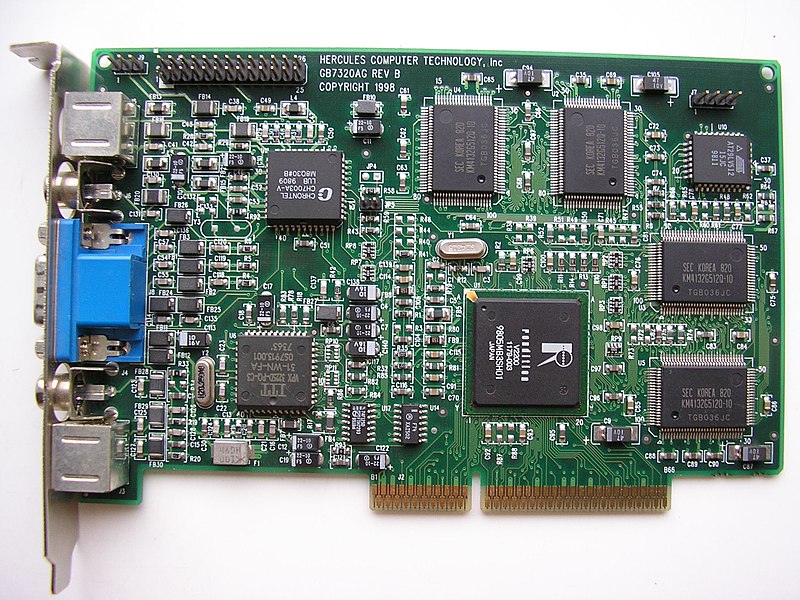 Thriller 3D Thriller 3D
Launched: Late 1997
Chipset: Rendition Verite 2200
Bus: PCI or AGP
Memory: 4 MB or 8 MB SGRAM
RAMDAC Speed: 230 MHz
Price: ?
FCC ID:
The Hercules Thriller 3D used the Rendition Verite 2200, an update to their earlier Verite 2100 with a faster RAMDAC compared to the 170 MHz Verite 2100. The Thriller 3D card came with a choice of either 4 MB or 8 MB of SGRAM.
The card came with both video-in and video-out ports.
|
 Stingray 2 / Stingray 2/TV Stingray 2 / Stingray 2/TV
Launched: 1998
Chipset: 3dfx Voodoo2
Bus: PCI
Memory:
Core Clock Speed: 93 MHz
RAMDAC:
Price: ?
FCC ID:
The Hercules Stingray 2 was their 3dfx Voodoo 2 card, launched in 1998.
A version of the card called the Stingray 2/TV was also released. The only difference was the addition of a TV-out (S-Video and Composite) port.
|
 Terminator 128/3D Terminator 128/3D
Launched: 1998
Chipset: S3 Trio3D
Bus: AGP 2x
Memory: 8 MB SDRAM (128-bit, 10ns)
Memory Speed: 100 MHz
RAMDAC Speed: 230 MHz
Price: ?
FCC ID:
The Hercules Terminator 128/3D was built around S3's Trio3D chipset, an enhanced 128-bit graphics engine that also contained the 3D engine from the ViRGE/GX2.
It was compatible with DirectX 5.
|
 Dynamite TNT Dynamite TNT
Launched: Late 1998 / Early 1999
Chipset: nVidia RiVA TNT
Bus: AGP
Core Clock: 95 MHz
Memory: 16 MB SDRAM
Memory Speed: 125 MHz
RAMDAC Speed: ?
Price: ?
FCC ID:
The Hercules Dynamite TNT was based around the nVidia RiVA TNT chipset, and was one of the last cards to be produced using this chipset. By default it overclocked the core and memory over other cards that used the same chipset.
|
 3D Prophet 4000XT 3D Prophet 4000XT
Launched: 2000
Chipset: ST Microelectronics STG4000 (Kyro)
Bus: AGP 4x
Memory: 32 MB SDRAM
Memory Speed: 115 MHz
Core Clock: 115 MHz
RAMDAC Speed: 270 MHz
Price: ?
FCC ID:
The Hercules 3D Prophet 4000XT came with a 32-bit integrated RAMDAC. The card provided an S-Video and TV-out in addition to its standard 15-pin VGA port.
It was compatible with Direct3D 6 and OpenGL 1.1.
|
 3D Prophet 4500XT 3D Prophet 4500XT
Launched: 2001
Chipset: ST Microelectronics STG4500-X (Kyro II)
Bus: AGP 4x
Memory: 64 MB SDRAM
Memory Speed: 175 MHz
Core Clock: 175 MHz
RAMDAC Speed: 300 MHz
Price: ?
FCC ID:
The Hercules 3D Prophet 4500XT used the updated chipset from ST Microelectronics, the STG4500-X, and came with a 32-bit integrated RAMDAC which ran at 300 MHz.
It was compatible with Direct3D 6 and OpenGL 1.1.
|

.png)

.png)



.png)
.png)

.png)




.png)

















